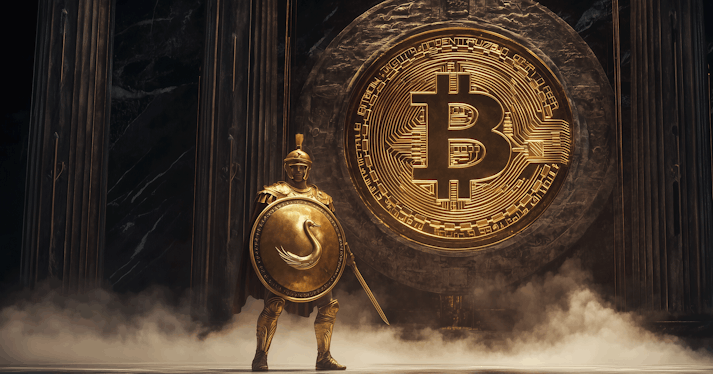There has been a long-lasting concern that Bitcoin’s price appreciation is driven by the creation of an artificial digital dollar called Tether. This particular piece of FUD (fear, uncertainty, doubt) appeals to the popular intuition that Bitcoin is little more than a Ponzi scheme. Rather than dig deeper into questions like, “What is money?” and, “What makes good money?” these critics lead with the answer they want and find circumstantial evidence later.
However, it’s become evident that Tether is not the driver of Bitcoin’s rallies. Instead, Tether’s growth is evidence of the genuine demand for a digital dollar that arose naturally in the world’s first 24⁄7 global financial marketplace.
Why Does Tether Exist?
Tether originated as a digital dollar on Bitfinex, one of the older and larger Bitcoin exchanges that operate primarily in Asia. When a user deposited funds into their Bitfinex account, their dollars were deposited into the Bitfinex bank account, and the user was credited with an equivalent amount in Tether they could use freely on the trading platform Importantly, these Tethers, an unforgeable digital asset, can be removed from the Bitfinex platform and stored in an individual’s self-custodied cryptocurrency wallet.
In essence, Tether was a way for Bitfinex to grant its users a bearer digital dollar that they could control themselves, gaining some of the digitized advantages of Bitcoin while remaining pegged to the U.S. Dollar’s value.
Why Were So Many Created?
In 2017, the demand for Bitcoin and other cryptocurrencies spiked worldwide. But, it did not spike uniformly. Because of variances in interest and access to trading venues, different parts of the world experienced the 2017 bull market in different ways. In the United States, trading venues were flooded with demand for new accounts and hopelessly backlogged. Coinbase was the largest and most established, making it comparatively easy to set up an account and buy without much delay. As a result, a disproportionate amount of new demand funneled into Coinbase, bidding up the price of Bitcoin there.
Other exchanges did not see such a stark influx of new demand. Because Bitfinex had one of the slowest new customer onboarding and approval processes, it saw a comparatively small spike in demand relative to Coinbase. As a result, the price of Bitcoin on Coinbase was bid up to significantly higher prices than on Bitfinex.
Professional traders who had already established accounts with higher limits on both platforms stepped in to take advantage of this arbitrage opportunity.
These traders could sell Bitcoin on Coinbase at high prices and withdraw the dollar proceeds from their accounts. Then, they could wire these dollars to Bitfinex, which would be posted to their Bitfinex account as Tether. With their Bitfinex account funded, they could buy Bitcoin at market prices lower than on Coinbase. With these funds now converted to Bitcoin, they could send that Bitcoin from their Bitfinex account to their Coinbase account and sell at the higher market rates there. This same process could be repeated over and over, cycling up to $20M daily (Coinbase’s highest withdrawal limit for professional accounts). Over several months, professional traders like Dan Matuszewski at Circle Trade deposited billions of dollars into Bitfinex through this mechanism, creating billions of 1‑to‑1 digital Tethers.
Why Have Tethers Accumulated?
Tether’s utility is often overlooked: Tether is more beneficial to a digital asset trader than a dollar is. Every time a dollar moves, it is subject to slow traditional banking processes and scrutiny. Traders looking to move funds between venues would instead transact with a digital dollar unencumbered by traditional banking rails.
Because of the greater utility of Tethers compared to actual dollars, there was ample demand to use them outside of Bitfinex. Trading venues worldwide responded to the demand by creating Bitcoin/Tether trading pairs and allowing users to deposit and withdraw Tethers.
As a result, the use of Tethers proliferated across digital asset markets. With demand for Tethers exceeding users' interest in redeeming them for dollars, the number of Tethers in circulation soared.
Was Tether Creation Driving Bitcoin’s Price Increases?
To a certain extent, Tether creation would be a leading indicator of demand for Bitcoin on Bitfinex, as users funding their accounts are creating new Tethers before they use them to bid for Bitcoin.
However, the bigger claim by skeptics, unfamiliar with an old saying about correlation and causation, is that Tether’s creation was the reason that Bitcoin’s price was going up in the first place. Indeed, the number of Tether in circulation moves in lock-step with the price of Bitcoin during bull markets. However, the reasonable explanation is that Tether creation is the lagging indicator: a byproduct of new dollars coming into the market.
Is Tether’s Continued Growth Evidence That it is a Giant House of Cards?
At this point, 20B Tethers are in circulation in the global digital asset market. Tethers continue to be created at a rate faster than they are redeemed for dollars. Rather than evidence of some gigantic fraud, this continued growth is testament to the utility of digital dollars.
Beyond its superior transfer qualities, Tether has increasingly been adopted by global citizens who would like to hold dollars despite their national banking systems forbidding it. For example, there is significant demand in China for Tethers. Even though they are simply promissory notes for dollars held in a company’s bank account, the demand for them is very real due to the restrictions preventing individuals from holding real dollars.
This demand is evidenced by Tether trades above its $1/Tether issuance rate. Over the last year, Tether has traded on average at $1.0005/Tether, meaning a 5 bps premium. It’s simple to see why the total number of Tethers in circulation keeps increasing: the global market views them as more valuable than dollars because of their broader utility and access compared with dollars.
Isn’t Tether Mired in Legal Controversy?
Tether is involved in legal proceedings with the NY Attorney General’s office. It is alleged that there was an improper loan of $850M from Tether to Bitfinex, allegedly made to cover a loss of customer funds as a result of fraud by one of Bitfinex’s payment processors, Crypto Capital.
These accusations are serious but independent from the question of whether Tether themselves are properly collateralized with bank account holdings. Indeed, it’s worth noting the glaring lack of regulatory action against Tether on this front, suggesting that authorities do not have reason to believe that Tether has fraudulently created unbacked digital dollars. With $20B in question, it’s almost certain that United States authorities are keeping a close eye on the banking activity underpinning Tether’s operation.
What’s the Future For Tether?
Tether enjoys a large early lead in the digital synthetic dollar market, but competitors like USDC have sprung up and purport greater transparency and regulator-friendly governance. The qualities of these newer entrants may chip away at Tether’s lead and eventually replace it as the preferred digital dollar in time.
However, it may be that Tether’s scrappy origins and less open relationship with banking regulators provide it a subtle staying power. For users in China seeking to hold Tether as an alternative means to holding dollars, Tether’s reputation of being less cooperative with regulators than its competitors could be perceived as positive. For users seeking dollar exposure less resistant to government seizure or shutdown, that less friendly stance towards regulators may help keep Tether as the preferred digital dollar into the future.
Sign up to start saving Bitcoin
Buy automatically every day, week, or month, starting with as little as $10.










